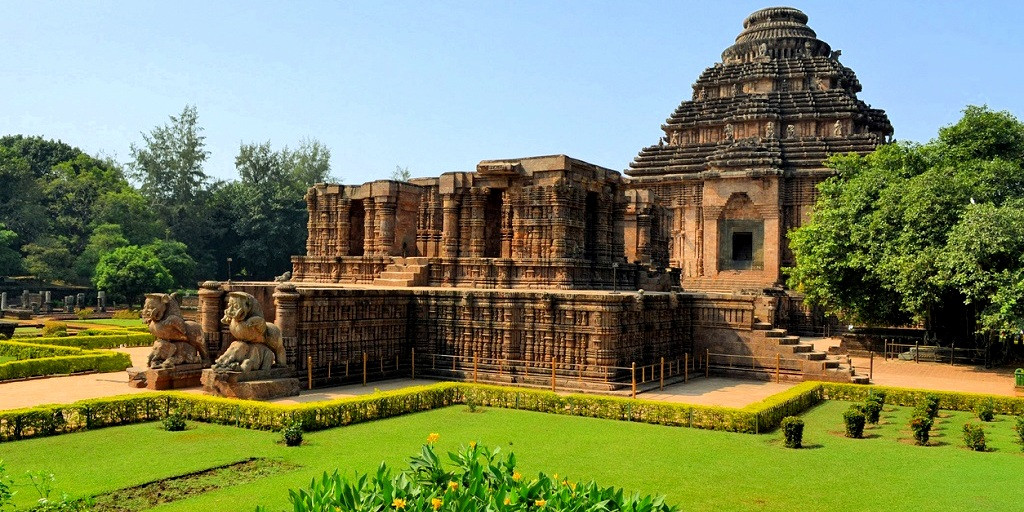Taj Mahal, Agra
The Taj Mahal in Agra is not only one of the most iconic symbols of India but also a universally admired masterpiece of world heritage. Built by Mughal Emperor Shah Jahan in memory of his beloved wife Mumtaz Mahal, who died during childbirth, this monument is a testament to love and the artistry of Mughal architecture.
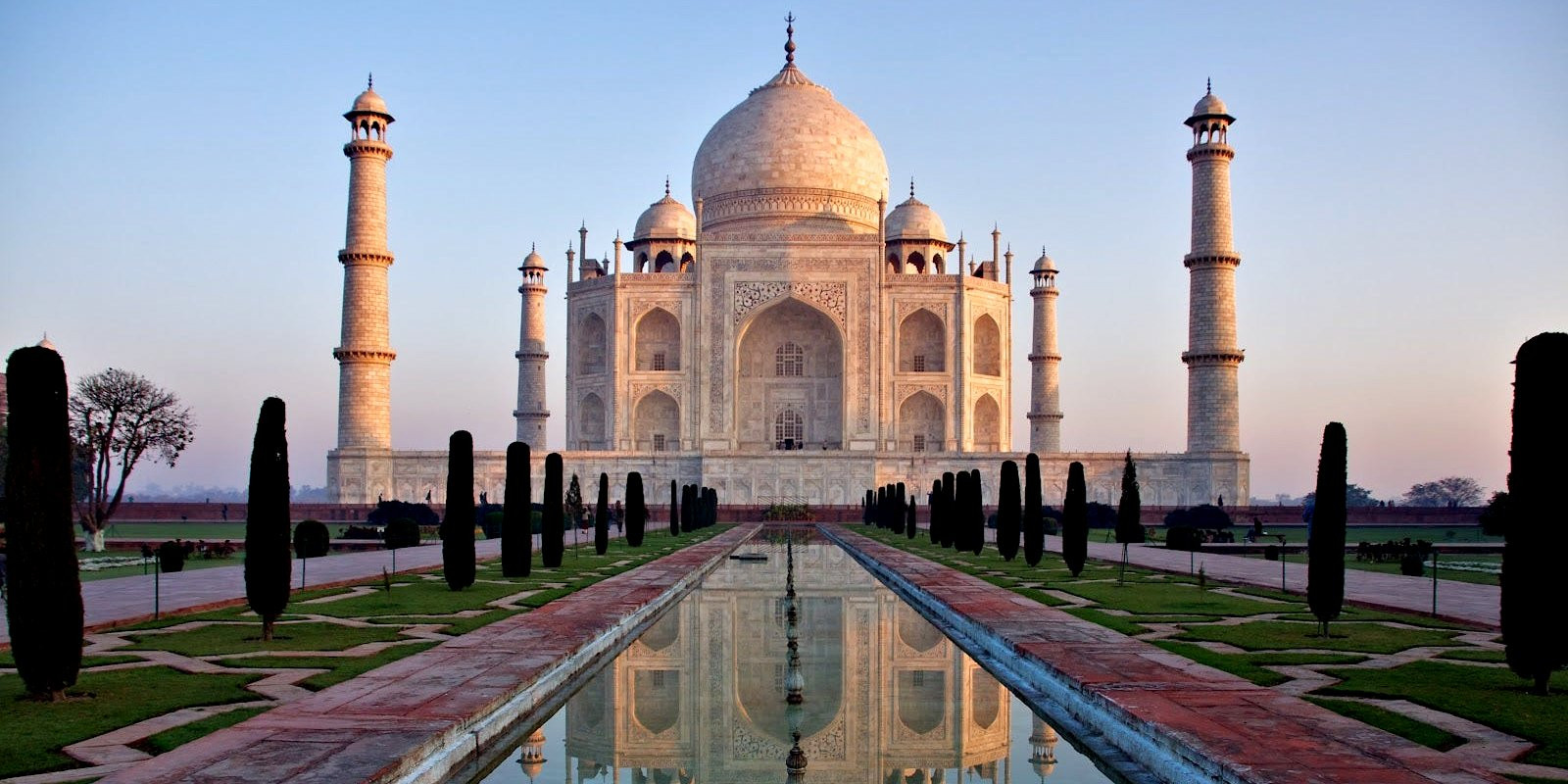
Key Features
-
Material: The Taj Mahal is primarily constructed from white marble which was sourced from Makrana in Rajasthan, embellished with precious and semi-precious stones inlaid into the marble.
-
Architecture: It combines elements from Islamic, Persian, Ottoman Turkish, and Indian architectural styles. The Taj Mahal is renowned for its symmetrical proportions and intricate craftsmanship. The main structure is crowned by a large dome and surrounded by four smaller domes.
-
Complex: The entire complex is set within a formal garden bounded on three sides by a crenellated wall. Apart from the mausoleum, the complex includes a mosque, a guest house, and the main gateway. The river-facing side is open, originally flowing with the river Yamuna.
-
Inscriptions: Verses from the Quran are inscribed on the mausoleum’s large pishtaq or vaulted archways, and throughout the complex, enhancing its spiritual presence.
- Gardens: The charbagh garden, a Persian-style garden split by waterways and pathways into four parts, reflects the paradise garden described in the Quran.
Cultural Significance: The Taj Mahal is a UNESCO World Heritage Site and is considered one of the finest examples of Mughal architecture in the world. It attracts millions of visitors each year and is celebrated for its story of love and loss, as well as its breathtaking beauty. The Taj Mahal also plays a critical role in India's tourism and cultural identity, symbolizing its rich history.
Visiting the Taj Mahal is a profound experience, reflecting not only the artistic and architectural achievements of a bygone era but also the depth of emotion and cultural richness of Mughal India. Whether viewed at dawn or dusk, the Taj Mahal remains one of the most captivating and serene monuments globally.
Qutub Minar, Delhi
Qutub Minar in Delhi is a towering testament to medieval Indian architecture and one of the most famous historical landmarks in India. It is part of the Qutb complex, which also houses various other ancient structures, and is a UNESCO World Heritage Site. The minaret stands at an impressive height of 73 meters (239 feet) and is the tallest brick minaret in the world, making it a significant attraction in Delhi.
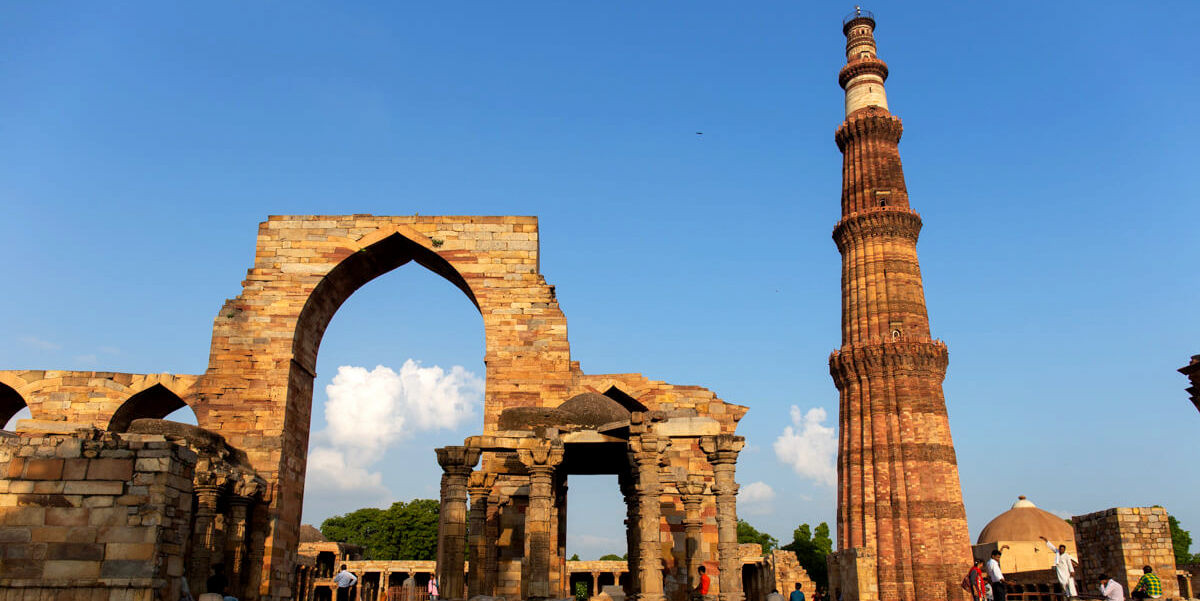
Key Features
-
Construction: The construction of Qutub Minar began in 1193 under the orders of Qutb-ud-din Aibak, the founder of the Delhi Sultanate, and was completed by his successor, Iltutmish. It is made of red sandstone and marble, and is an exquisite example of Indo-Islamic Afghan architecture.
-
Design: The tower has a fluted cylindrical shaft, with a base diameter of 14.3 meters that narrows to 2.7 meters at the top, divided into five distinct stories. Each floor is marked by a projecting balcony, encircled by stone brackets which are decorated with honeycomb designs, more prominent in the first three floors.
-
Inscriptions: The tower features intricate inscriptions in Arabic across its different sections, including verses from the Quran and details about its construction.
-
Iron Pillar: Within the complex stands the famous Iron Pillar of Delhi, known for its rust-resistant composition of metals, which dates back to the 4th century AD and bears an inscription in Sanskrit in Brahmi script of King Chandragupta II.
-
Architectural Ensemble: The complex includes several other historically significant structures such as Alai Darwaza, the beautifully carved entrance to the mosque; Quwwat-ul-Islam Mosque, the first mosque built in India; and the tomb of Iltutmish.
Cultural Significance: Qutub Minar not only marks the beginning of Muslim rule in India but also depicts the victory of Muhammad Ghori over the Rajput king, which led to the establishment of the Delhi Sultanate. It is a symbol of Islamic architectural prowess and an important example of Mughal architecture's evolution in India.
Visiting Qutub Minar offers a deep dive into India’s rich past and provides a picturesque backdrop for photography enthusiasts and history buffs alike. It stands not just as a monument but as a storied structure offering insights into the rich tapestry of historical narratives of Delhi.
Red Fort, Delhi
The Red Fort in Delhi, also known as Lal Qila, stands as a powerful symbol of India's rich history and is one of the most significant historical landmarks in the nation's capital. Built by the fifth Mughal Emperor Shah Jahan in 1638, it was designed to be the palace fort of his capital, Shahjahanabad. This UNESCO World Heritage Site is not only a popular tourist attraction but also plays a crucial role in India's contemporary ceremonial life, notably during the Independence Day celebrations.
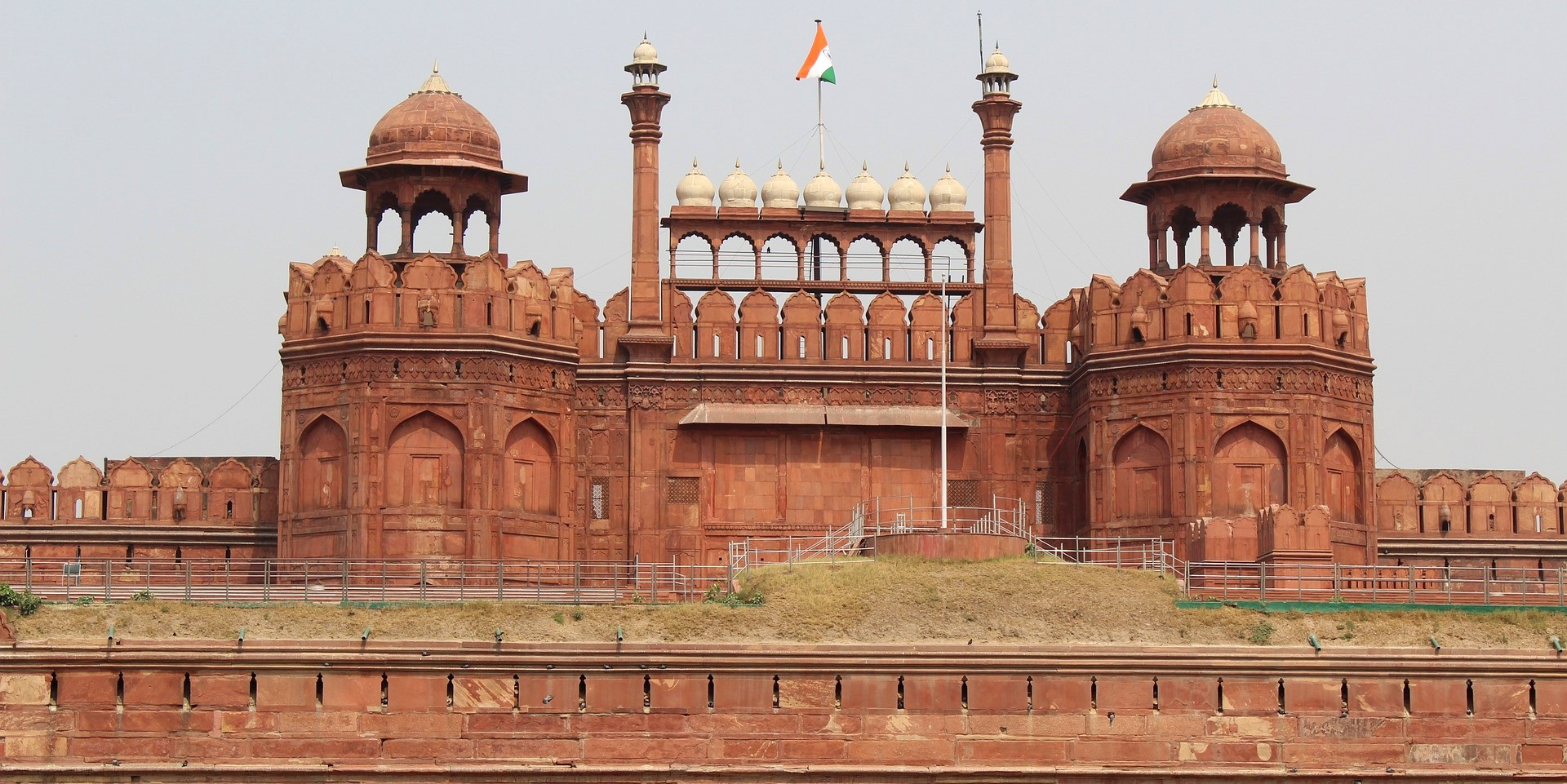
Key Features
-
Architecture: The fort's massive walls, built out of red sandstone, stretch for about 2.5 kilometers and vary in height from 18 meters on the river side to 33 meters on the city side. The architectural style is a blend of Persian, Timurid, and Indian, which was typical of the Mughal era.
-
Main Gates: The fort has two main gates - the Lahore Gate and the Delhi Gate. The Lahore Gate, which faces Lahore (now in Pakistan), is the more famous of the two and is traditionally used for the Prime Minister's Independence Day speech.
-
Public and Private Halls: Inside, the fort encompasses several important buildings including the Diwan-i-Aam (Hall of Public Audiences) where the emperor would hear public petitions, and the Diwan-i-Khas (Hall of Private Audiences) which housed the famous Peacock Throne and where the emperor met with courtiers and state guests.
-
Royal Residences: The fort also includes the imperial apartments consisting of a row of pavilions connected by a water channel known as the Nahr-i-Bihisht (Stream of Paradise). The Khas Mahal served as the emperor's private residence.
-
Rang Mahal: The Rang Mahal, or the 'Palace of Colours', housed the emperor's wives and mistresses. Its ceiling was covered with gold silver and the floor was embedded with precious stones.
Cultural Significance: The Red Fort is more than just a stunning example of Mughal architecture; it symbolizes the peak of the Mughal empire in India. The fort’s planning and aesthetics represent the zenith of Mughal creativity which prevailed during the reign of Emperor Shah Jahan.
Historical Importance: During the colonial period, the fort was used as a garrison by the British Army, and a large part of its precious artefacts and jewels were looted during this time. Post-independence, significant parts of the fort were restored. As a symbol of national pride and a site of significant historical narratives, the Red Fort attracts millions of visitors both from India and around the world, eager to get a glimpse of India's glorious past and its continuing cultural heritage.
Visiting the Red Fort provides an insightful glimpse into the architectural and historical grandeur of the Mughal Empire, making it a must-visit for anyone interested in the rich tapestry of India's history.
Amber Fort, Jaipur
Amber Fort, also known as Amer Fort, is located in Amer, a town with an area of 4 square kilometers located 11 kilometers from Jaipur, Rajasthan, India. This majestic fort is one of the most famous forts of Rajasthan and was built by Raja Man Singh I in 1592. It is an excellent example of Rajput architecture and offers a breathtaking view of Maota Lake, which lies in front of the fort.
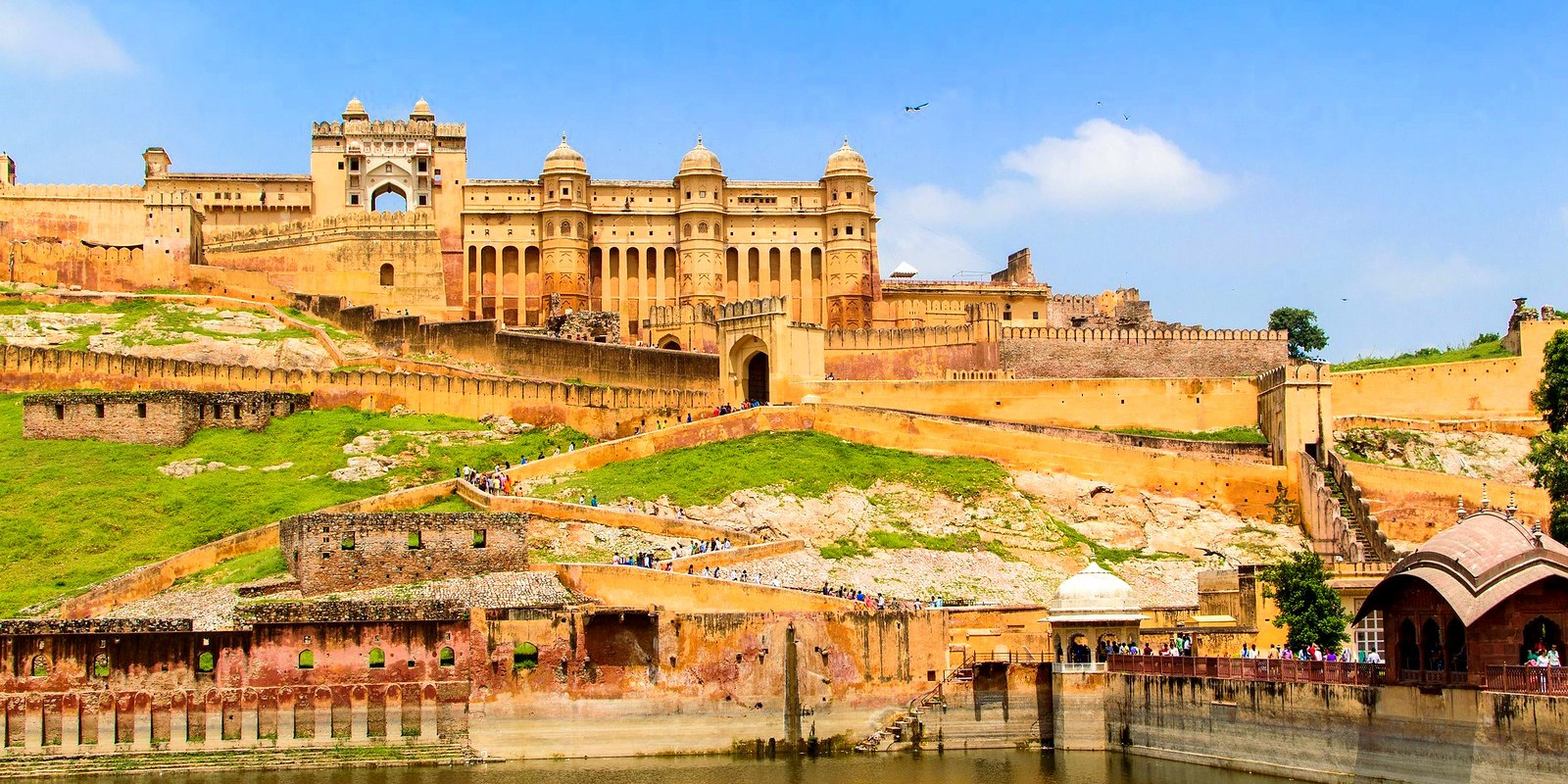
Key Features
-
Architecture: Amber Fort is renowned for its blend of Hindu and Mughal architectural styles. Constructed primarily of red sandstone and marble, the fort consists of a series of four courtyards, palaces, halls, and gardens. Each section of the fort has its distinct architectural style and decoration, reflecting the richness of Rajput decor.
-
Sheesh Mahal (Mirror Palace): One of the most famous parts of Amber Fort is the Sheesh Mahal or Mirror Palace. The walls and ceiling of this palace are covered with thousands of mirror tiles and colored glasses, which reflect any streak of light, illuminating the entire room.
-
Diwan-e-Aam (Hall of Public Audience): This is a large hall where the kings held public meetings and listened to the public's needs and complaints. It features a raised platform for the king and two rows of columns, each adorned with elephant-head carvings, which support the roof.
-
Diwan-e-Khas (Hall of Private Audience): Smaller than the Diwan-e-Aam, this hall was where the king would meet with his ministers and court members to discuss private matters of the state.
-
Ganesh Pol: An impressively decorated gateway that leads to the private palaces of the maharajas. It is named after the Hindu god Lord Ganesh, who removes all obstacles in life.
Cultural Significance: Amber Fort is a prime example of the artistic and architectural achievements of the Rajput rulers during their reign. It reflects the valor and lifestyle of the Rajputana era through its grandiose structure and the intricate detail in its carvings and ornamentation.
Visitor Experience: Tourists can enjoy an elephant ride up the hill to the fort, which offers a royal experience reminiscent of the fort's glorious past. The fort also hosts a light and sound show in the evening, which narrates the rich history of Jaipur and the fort itself.
Historical Importance: Amber Fort served as the residence of the Rajput Maharajas and their families. At the same time, it was also a strategic fort that stood against invading enemies. It remained the capital of the Kachwaha Rajputs for many years before the capital was moved to Jaipur. The fort’s extensive palatial complex has influenced both Hindu and Islamic architecture across the region.
Visiting Amber Fort offers a journey back in time to explore the opulent lifestyle of the Rajput rulers, and it remains a profound testament to the ingenuity and craftsmanship of Rajput architects. Its combination of picturesque scenery, rich history, and architectural splendor makes it a must-visit for anyone traveling to Rajasthan.
Mysore Palace, Mysore
Mysore Palace, also known as the Amba Vilas Palace, is a historical palace and the royal residence at Mysore in the Indian State of Karnataka. It is one of the most splendid royal buildings in India and the seat of the Kingdom of Mysore, which was ruled by the Wadiyar dynasty. The palace is the centerpiece of the annual Mysore Dasara festival and attracts millions of tourists from around the world.
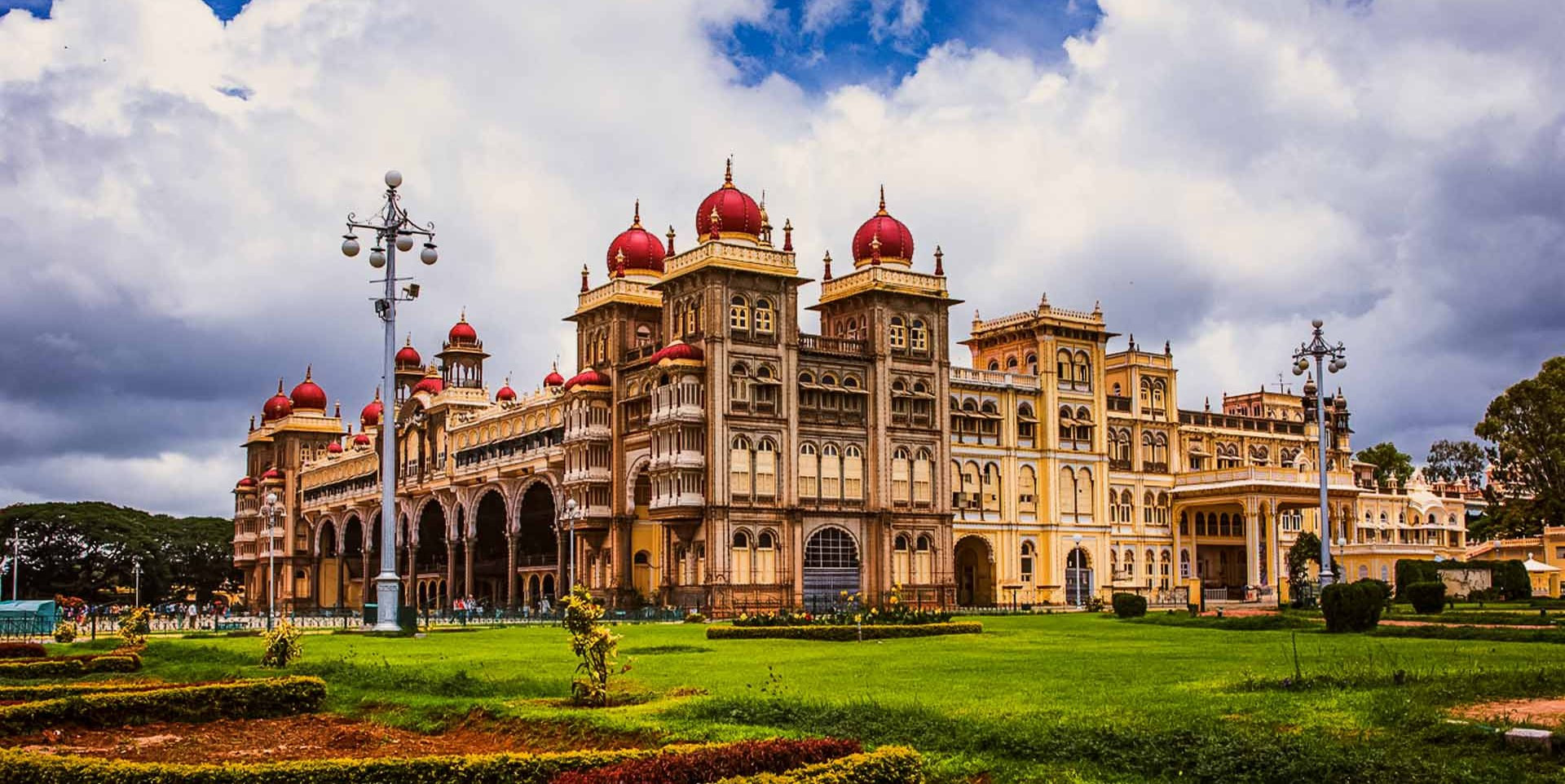
Key Features
-
Architecture: The current structure of Mysore Palace was completed in 1912 by the British architect Henry Irwin, after the old palace was destroyed by a fire during the wedding of Princess Jayalakshmanni. The architecture is a harmonious synthesis of Hindu, Muslim, Rajput, and Gothic styles, which gives it a unique regal quality.
-
Three-dimensional facade: The palace's facade is a three-dimensional composition of domes, arches, turrets, colonnades, and sculptures. The intricate craftsmanship and ornate details in the interior are just as impressive, featuring beautifully carved wooden doors, mosaic floors, and expansive halls.
-
Durbar Hall: Known for its lavish and ornate interiors, the Durbar Hall is where the royal ceremonies and meetings were held. It has an ornate ceiling and many sculpted pillars.
-
Gallery: The palace houses an extensive gallery with paintings and artifacts from all over the world, showcasing the opulence of the royals who once lived there.
-
Light & Sound Show: The palace hosts a light and sound show that narrates the story of the palace against the backdrop of its illuminated façade, enhancing the visitor's experience and providing historical context.
Cultural Significance: Mysore Palace embodies the splendor of a bygone era and showcases the opulence of the Indian royal states. The palace is especially significant during the Dasara festivities when it is spectacularly lit up and becomes the epicenter of celebrations. The Mysore Dasara is an important cultural festival in Karnataka, attracting large crowds for its processions and cultural performances.
Visitor Experience: Visitors can marvel at the palace's grandeur, particularly during the evenings when it is brilliantly lit up with Mysore Palace light timing generally around 7:00 PM every Sunday, during public holidays and during the Dasara celebrations, when nearly 100,000 light bulbs illuminate the palace structure.
Historical Importance: The palace not only serves as a major tourist attraction but also plays a critical role in preserving the cultural heritage of the region. It offers insight into the rich history of the Wadiyar dynasty that ruled Mysore for several centuries. The architectural style of the palace influences modern constructions within the region and serves as a testament to the skill of Indian craftsmen over the centuries.
Mysore Palace is not just an architectural gem but a symbol of the cultural heartland of Karnataka, offering a glimpse into the state’s regal past and continuing traditions of Indian royalty.
Ajanta and Ellora Caves, Maharashtra
The Ajanta and Ellora Caves, located in the Aurangabad district of Maharashtra, India, are a magnificent complex of ancient cave temples that represent the pinnacle of Indian rock-cut architecture. These UNESCO World Heritage Sites are celebrated for their extraordinary carvings, sculptures, and frescoes that offer a unique glimpse into the religious and artistic traditions that flourished in ancient India.
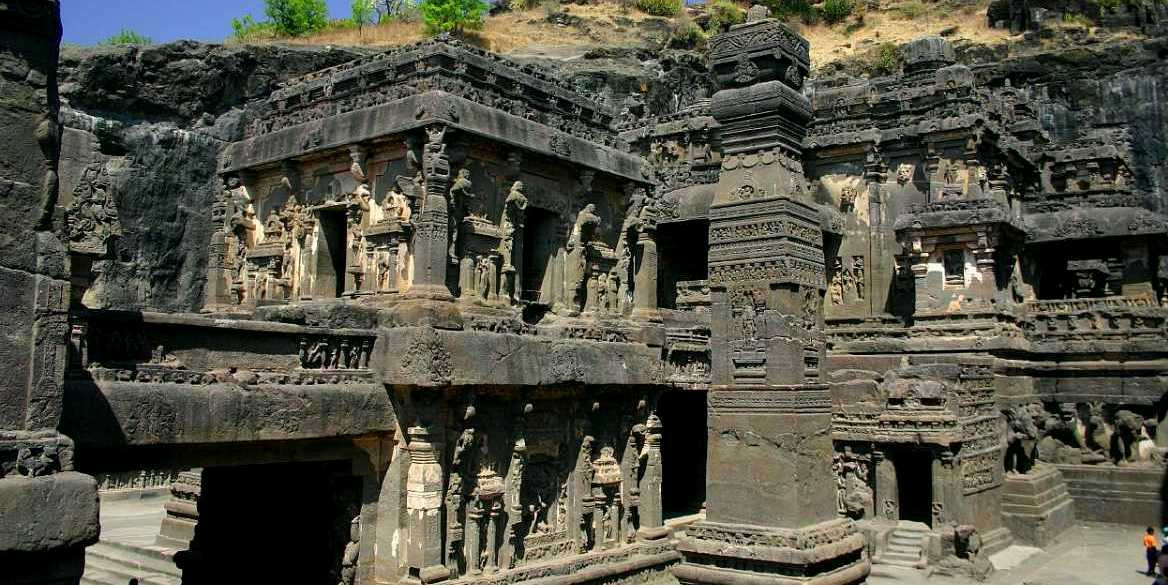
Key Features
-
Ajanta Caves: The Ajanta Caves consist of 29 Buddhist cave temples that date back to the 2nd century BCE to about 480 CE. These caves are renowned for their stunning frescoes and sculptures that depict various episodes from the life of Buddha and scenes from everyday life of that era. The paintings in the Ajanta Caves are notable for their narrative richness and vibrant colors.
-
Ellora Caves: Unlike Ajanta, the Ellora Caves are a more extensive complex of 34 caves that were excavated between the 6th and 11th centuries CE. These caves are unique in that they house Buddhist, Hindu, and Jain temples and monasteries, demonstrating the religious harmony prevalent during this period of Indian history. The most remarkable among these is Cave 16, the Kailasa Temple, a massive rock-cut temple dedicated to Lord Shiva, designed to mimic Mount Kailash, his mythological abode.
-
Cultural Significance: The Ajanta and Ellora caves provide significant insights into the evolution of Indian art and architecture over centuries. The artistic and architectural details in these caves reflect the sophisticated techniques used by ancient craftsmen and the spiritual and philosophical zeitgeist of their times.
-
Visitor Experience: Ajanta Caves location: Nestled in a panoramic ravine, visitors are treated to a view of a curved river gorge with forested cliffs on both sides.
-
Ellora Caves opening hours: Typically, Ellora Caves are open from sunrise to sunset, except on Tuesdays, allowing ample time for visitors to explore these architectural marvels.
-
Historical Importance: The caves were built in two different periods – the first group was built around the 2nd century BCE, when trade routes expanded and Buddhism flourished under the patronage of Indian dynasties like the Vakataka. The later group of caves built at Ellora reflects the religious diversity of India, with beautiful shrines dedicated to various Hindu gods and goddesses as well as Jain Tirthankaras, constructed under the patronage of the Rashtrakuta dynasty.
For anyone interested in ancient history, religious art, or architecture, a visit to the Ajanta and Ellora Caves is an enlightening journey through India's rich heritage, offering a profound look at the artistic achievements of ancient times.
Konark Sun Temple, Odisha
The Konark Sun Temple, located in the eastern Indian state of Odisha, near the sacred city of Puri, is a monumental representation of the chariot of the Sun God, Surya. Built in the 13th century by King Narasimhadeva I of the Eastern Ganga Dynasty, the temple is one of India's most famed architectural wonders and a UNESCO World Heritage Site.
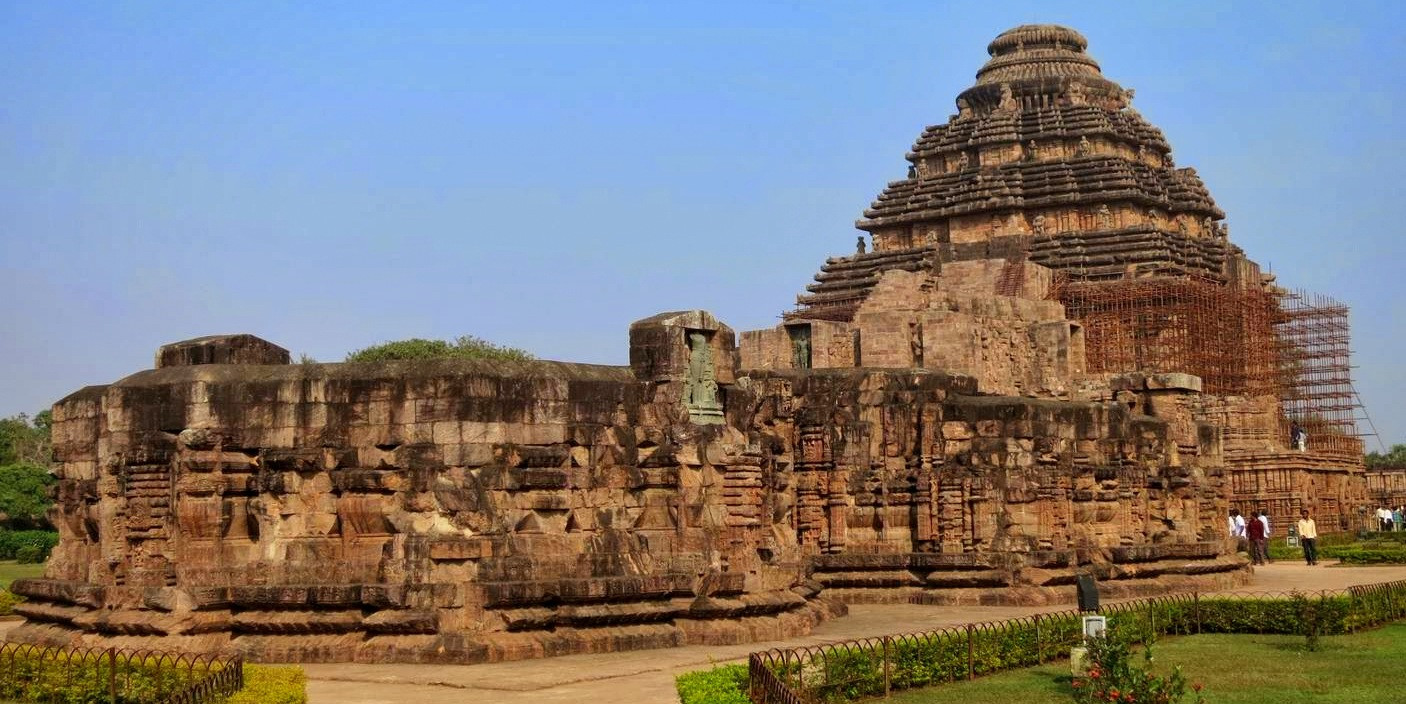
Key Features
-
Architectural Design: The temple's entire structure is shaped like a gigantic chariot, complete with twelve pairs of elaborately carved stone wheels, pulled by seven horses, and a majestic spire that once towered over the landscape. Although the main sanctum has since fallen into ruin, the remaining structures impressively display the intricate artisanship of the time.
-
Stone Wheels: Each of the wheels at the base of the temple is sculpted meticulously and serves as sundials that accurately tell time. The spokes of the wheels create shadows that move with the sun and can be used to calculate precise time intervals.
-
Sculptures: The temple surfaces are vividly carved with a variety of intricate designs, including deities, dancers, scenes of life at court, and mythical creatures. These sculptures offer a glimpse into the cultural life of the era and are considered masterpieces of Indian art.
-
Orientation: The temple was ingeniously positioned so that the first rays of the rising sun struck the principal entrance, illuminating the interior and the deity placed within.
Cultural Significance: Konark Sun Temple is a testament to the engineering genius and artistic mastery of ancient India. Its construction not only reflects the religious significance of worshipping the Sun God, crucial for the prosperity and well-being of the people but also represents the zenith of Indian temple architecture during its period.
Visitor Experience: Visitors to Konark are treated to the awe-inspiring sight of the temple’s remains, which, despite their partial ruin, continue to be a source of national pride and spiritual upliftment. The site is also host to the Konark Sun Temple festival, an annual festival of dance and music which attracts artists and spectators from across the world, turning the temple premises into a vibrant cultural hub.
Historical Importance: The temple’s original construction likely served both spiritual and scientific purposes, acting as a beacon for maritime navigators in the Bay of Bengal. Over the centuries, the temple has withstood the forces of nature and human interference but continues to be a profound symbol of India's rich historical and cultural fabric.
The Konark Sun Temple remains one of the most stunning monuments of religious significance in India. A visit to Konark offers insight into the ancient and medieval societal life of India, showcased through the art and architecture that has survived the test of time.
Hampi, Karnataka
Hampi, located in the southwestern state of Karnataka, is a UNESCO World Heritage Site known for its vast archaeological significance and striking landscapes. Once the illustrious capital of the Vijayanagara Empire in the 14th century, Hampi is celebrated for its extensive ruins, which include more than 1,600 remains of the last great Hindu kingdom in South India.
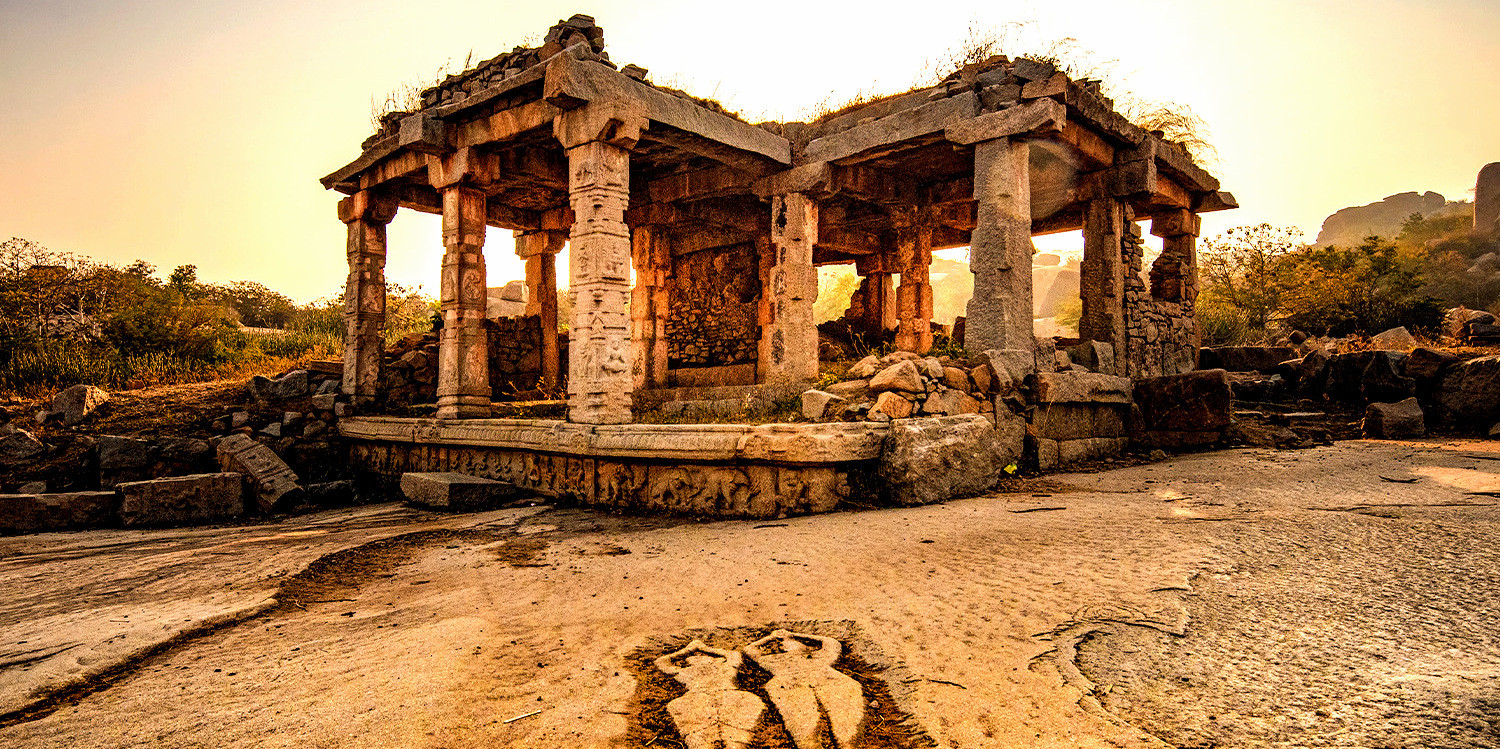
Key Features
-
Vast Site: Spread over 4,100 hectares, Hampi's ruins are a diverse collection of ancient temples, palaces, market streets, aquatic structures, bastions, royal pavilions, and stables.
-
Architectural Diversity: The architecture is a harmonious blend of Hindu and Islamic styles, reflecting the cosmopolitan culture of the Vijayanagara Empire. Iconic structures include the Virupaksha Temple, Vittala Temple with its famous stone chariot, and the Queen’s Bath.
-
Monolithic Sculptures: Hampi is notable for its large sculptures carved out of single boulders, such as the monolithic statue of Lord Ganesha (Kadalekalu Ganesha) and the monolithic Narasimha statue.
-
Boulder-strewn Landscape: The site's dramatic landscape is dotted with large boulders that were used in the construction of structures and also form natural defenses.
-
Agricultural Innovations: The irrigation systems used in Hampi during the Vijayanagara Empire were highly advanced, with elaborate aqueducts and canals for channeling water to the city’s numerous tanks and temples.
Cultural Significance: Hampi is a significant cultural and historical site, reflecting the grandeur of the Vijayanagara Empire, which was known for its support of art and architecture as a means of showcasing its power and wealth. The ruins of Hampi have been meticulously preserved to give visitors insight into the life of the South Indian dynasty.
Visitor Experience: Tourists visiting Hampi can explore the area on foot or rent bicycles, which are an excellent way to navigate the large distances between structures. The government and various NGOs offer guided tours that explain the historical and architectural importance of the ruins. Hampi also offers a picturesque setting for photography enthusiasts.
Historical Importance: Hampi's historical importance extends beyond its physical structures. It was a thriving center for trade, attracting traders from as far as Persia and Europe. The empire was known for its administration, progressive agricultural practices, and as a hub for the arts, with Hampi being a pivotal center for the development of music, literature, and temple architecture.
For anyone interested in archaeology, history, or architecture, Hampi serves as a profound testament to India’s rich cultural past and its capabilities in creating advanced urban landscapes. It remains a must-visit for an immersive experience into the life and times of one of India’s greatest historical empires.
Gateway of India, Mumbai
The Gateway of India, located in Mumbai, Maharashtra, is one of the most distinctive monuments in India. Constructed in 1924, this majestic archway was built during the British Raj and stands at the waterfront area of Apollo Bunder, overlooking the Arabian Sea. It was originally erected to commemorate the visit of King George V and Queen Mary to India in 1911.
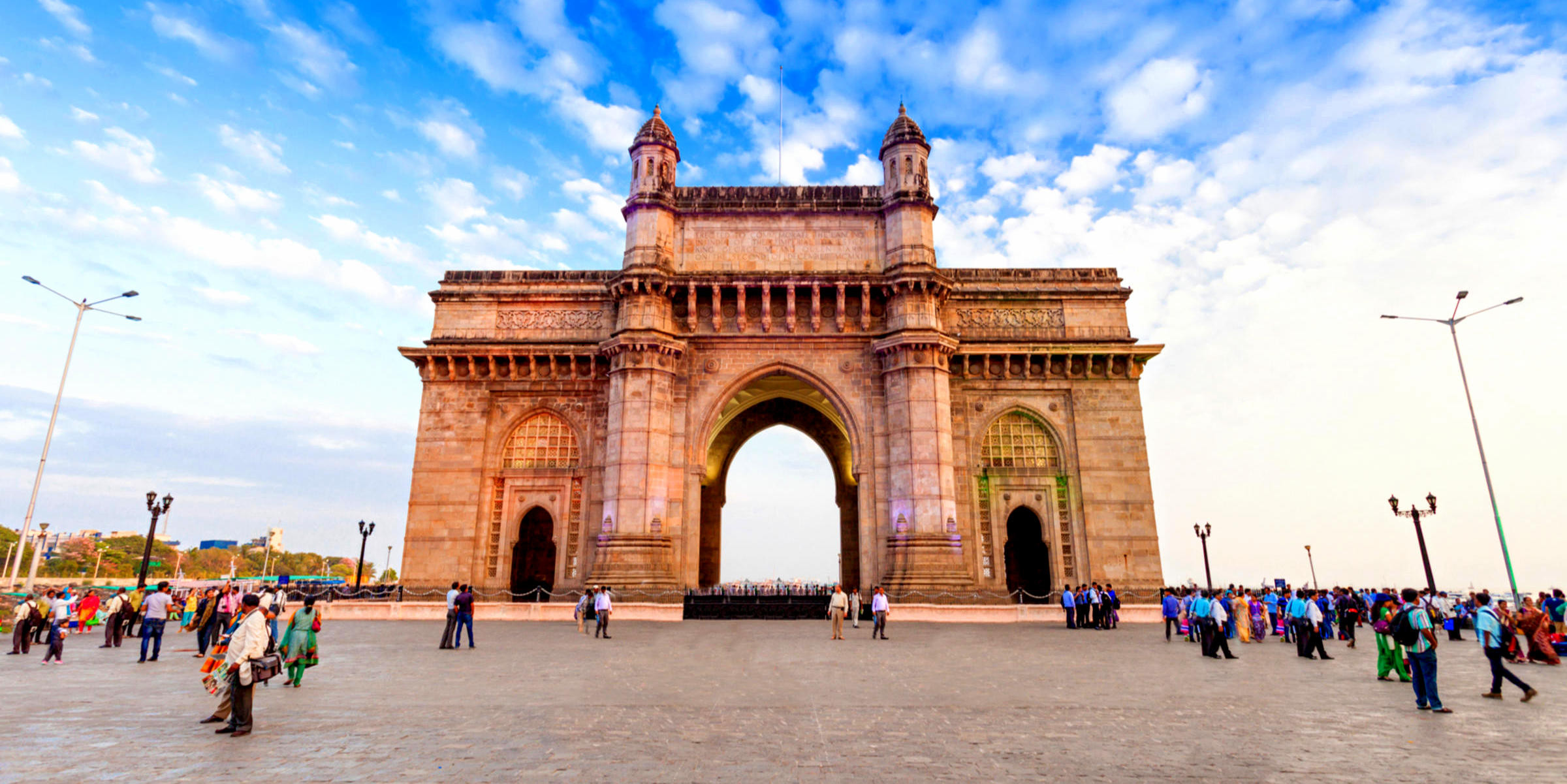
Key Features
-
Architectural Style: The Gateway of India is designed in the Indo-Saracenic style, combining elements of Hindu and Muslim architectural styles with Gothic influences. The structure is made from yellow basalt and reinforced concrete, standing as a grand and elegant arch with intricate latticework.
-
Historical Significance: Beyond its initial commemorative purpose, the Gateway of India also served as a symbolic ceremonial entrance to India for Viceroys and the new Governors of Bombay. It has witnessed numerous historical events, including the passage of British troops through the Gateway in 1948, marking the end of British rule.
-
Cultural Icon: Today, the Gateway of India is not just a tourist spot but a gathering place for locals, street vendors, and photographers, making it a bustling hub that reflects the vibrant life of Mumbai.
Visitor Experience: Visitors to the Gateway of India can enjoy a ferry ride from its piers to nearby locations such as Elephanta Caves and Alibaug. The area is also surrounded by other notable landmarks, including the Taj Mahal Palace Hotel, another architectural marvel, which offers a contrasting yet harmonious backdrop to the Gateway. The open area in front of the Gateway often hosts various cultural and music festivals, enhancing its status as a social and cultural meeting point.
Historical Importance: The Gateway of India holds a pivotal place in India’s modern history, serving as a symbol of the British Empire in India and later as a testament to the country’s struggle for independence. It witnessed the departure of the last British troops, making it an iconic reminder of India’s colonial past and its emergence as a sovereign nation.
Cultural Events: The Gateway is frequently the focal point for significant events, including the Gateway of India ferry services, which offer scenic routes to visitors wanting to explore the coastal beauty around Mumbai. Additionally, the monument is a favorite backdrop for numerous cultural and public gatherings, making it a lively spot throughout the year.
The Gateway of India is more than just a monument; it is a cultural hub that represents the spirit and resilience of Mumbai. It stands not only as a piece of architectural beauty but also as a silent witness to the narrative of a city that has continually evolved while embracing its past.
Mahabodhi Temple, Bodh Gaya
The Mahabodhi Temple, located in Bodh Gaya, Bihar, is one of the most sacred sites in Buddhism and marks the location where Siddhartha Gautama, the Buddha, attained enlightenment under a Bodhi Tree. This UNESCO World Heritage Site attracts pilgrims from all over the world, who come to meditate and pay homage at the spot that is considered the birthplace of Buddhism.
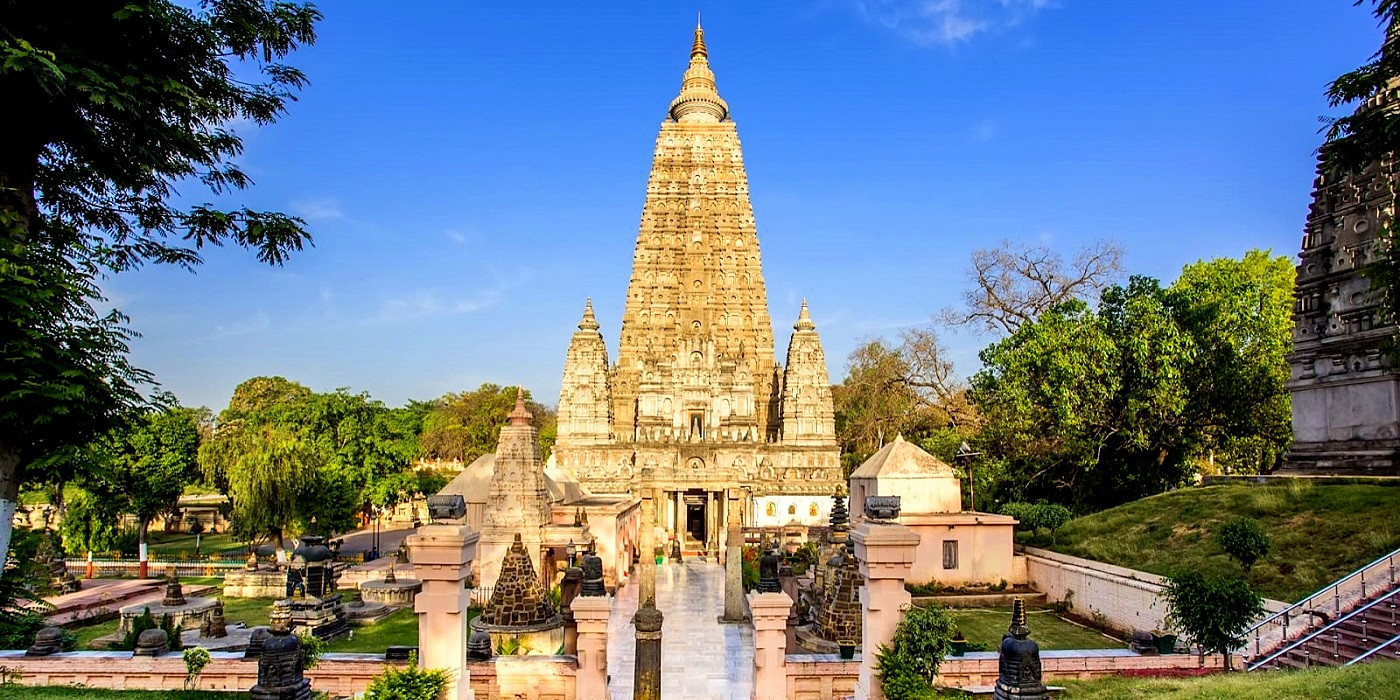
Key Features
-
The Bodhi Tree: The centerpiece of the temple complex is the sacred Bodhi Tree, under which Buddha is said to have attained enlightenment. The current tree is a descendant of the original and remains a focal point for meditation and prayer.
-
The Main Temple: The Mahabodhi Temple itself stands east of the Bodhi Tree and is a grand structure that rises to a height of 55 meters. It features a pyramidal spire adorned with carvings and statues of Buddha. The architecture reflects various phases of construction and renovations from as early as the 3rd century BC to the 6th century AD and later.
-
The Vajrasana: The stone platform known as Vajrasana, situated under the Bodhi Tree, is believed to be the exact spot where Buddha sat and attained enlightenment. It is a revered site for Buddhists.
-
Ancient Railings: Around the temple, ancient sandstone railings, some of which date back to about 150 BC, can be seen, bearing inscriptions and carvings in the early Brahmi script.
-
Other Structures: The complex also includes several other smaller temples and stupas, each significant to various aspects and stages of Buddha’s path to enlightenment and teachings.
Cultural Significance: The Mahabodhi Temple is not just an architectural wonder but also a living symbol of the spiritual teachings of Buddhism, representing peace, enlightenment, and liberation. It plays a crucial role in the religious life of Buddhists as a place of pilgrimage, similar to Mecca for Muslims and Jerusalem for Christians and Jews.
Visitor Experience: Visitors and pilgrims can participate in Mahabodhi Temple meditation sessions, which are held in the serene environs of the temple complex. The atmosphere is imbued with a sense of tranquility and introspection. The temple is especially vibrant during Buddha Purnima, the anniversary of Buddha’s birth, enlightenment, and death, when it is decorated elaborately and hosts thousands of pilgrims.
Historical Importance: The site has been a pilgrimage destination since the time of Ashoka, who is traditionally credited with the original construction of the temple. Over centuries, the temple complex was expanded and beautified by various patrons from different parts of the world, contributing to its status as a symbol of unity and a meeting point for diverse Buddhist traditions.
The Mahabodhi Temple not only marks the pivotal point in Buddha's spiritual journey but also stands as a testament to the endurance and spread of Buddhist philosophy throughout the centuries. Visiting the Mahabodhi Temple offers a profound connection to the past and an unparalleled insight into the spiritual heritage of Buddhism, making it a unique and unforgettable experience for any visitor.
Tips for Top 10 Historical Landmarks in India
Visiting the top historical landmarks in India is an enriching experience that offers deep insights into the country's rich heritage and architectural marvels. Here are some essential tips to enhance your visit to these iconic sites:
-
Plan Ahead: Research the best time to visit each landmark. Many sites can be particularly crowded during local festivals or holidays. Early mornings are typically less crowded and offer pleasant weather, especially for outdoor sites like the Taj Mahal and Hampi.
-
Buy Tickets in Advance: For popular sites like the Taj Mahal, it’s wise to purchase tickets online in advance to avoid long queues. This often also provides access to a faster entry line.
-
Hire a Guide: Consider hiring a knowledgeable local guide or joining a guided tour at landmarks like the Qutub Minar and Konark Sun Temple to gain a deeper understanding of the historical and architectural significance of these sites.
-
Dress Appropriately: Many historical sites in India are also places of worship. Dress modestly by covering shoulders and knees as a sign of respect, particularly at places like the Mahabodhi Temple and Ajanta Caves.
-
Stay Hydrated and Protected: Indian weather can be quite hot, especially in the summer months. Carry a water bottle, wear sunscreen, and bring a hat or umbrella for shade.
-
Check Opening Hours: Some sites, like the Ellora Caves, are closed on certain days of the week. Make sure to check the opening hours and any annual closures to plan your visit accordingly.
-
Photography Restrictions: Be aware of photography restrictions within certain areas of historic sites. Flash photography might be prohibited, especially in places with ancient frescoes like the Ajanta Caves.
-
Respect the Rules: Follow all posted rules and guidelines, such as not touching the frescoes or sculptures. This helps preserve these precious sites for future generations.
-
Security Checks: High-profile sites like the Red Fort and Gateway of India have strict security checks. Carry only essentials to ease your entry.
-
Explore the Surroundings: Often, the areas surrounding these landmarks have their own charm and history. For example, the markets outside Amber Fort offer traditional Rajasthani crafts and souvenirs.
-
Transportation: Plan your transportation in advance. Many sites, especially in larger cities like Delhi and Mumbai, are accessible by public transport. However, hiring a private car might be more convenient for remote locations like Hampi.
-
Stay Nearby: To truly experience the essence of these sites, consider staying in hotels or guesthouses close to the landmarks, especially in places like Jaipur and Agra, where you can enjoy early morning or night visits.
By following these tips, you can ensure a memorable and respectful visit to India's top historical landmarks, soaking in the rich history and culture that each has to offer.
Ideal time for Top 10 Historical Landmarks in India
When planning visits to India's top historical landmarks, choosing the right season can greatly affect your experience. Here’s how to align your visits with the seasons for optimal enjoyment:
-
Spring (March to May): Early spring is generally pleasant, but as the season progresses into late April and May, temperatures begin to rise significantly, making early morning visits advisable before the heat becomes intense.
-
Summer (June to August): This season, especially in areas receiving heavy monsoon rains, can offer lush, green landscapes but also presents challenges with rain and travel disruptions. It's a good time to visit places where the natural scenery enhances the site's beauty, although outdoor activities may be hampered by rain.
-
Monsoon (June to September): The monsoon season brings dramatic changes, especially in coastal areas where the seas turn rough. Fewer tourists visit during this time, which might offer a more solitary experience, but heavy rainfall can affect accessibility and comfort.
-
Autumn (September to November): The post-monsoon period sees a drop in temperatures and a reduction in dust and pollution, making it an ideal time for visiting. The weather is cooler and more comfortable for exploring outdoor sites.
-
Winter (December to February): This is generally the best time to visit, as the weather is cool and dry, ideal for spending long hours outdoors. Winters provide the most comfortable climate for exploring extensive archaeological sites and engaging in longer walking tours. Early mornings can be particularly magical, with a gentle mist that enhances the beauty of the settings.
General Tips
-
Early Mornings: Visiting landmarks early in the morning can help avoid the crowds and the intense sun later in the day, particularly in warmer months.
-
Festival Seasons: Planning a visit during local festivals can provide a vibrant, enriching experience but expect larger crowds and plan accordingly.
-
Stay Hydrated: Regardless of the season, it's important to stay hydrated, especially during the warmer months. Always carry water and wear appropriate sun protection.
Choosing the right time to visit based on seasonal conditions and personal preferences can enhance your experience, allowing you to fully appreciate the architectural and historical significance of each site.
India's Top 10 historical landmarks are a testament to the nation's rich heritage and architectural brilliance. From the iconic Taj Mahal to the ancient Ajanta and Ellora Caves, each site offers a distinct window into India's diverse history and culture. These landmarks go beyond being mere tourist attractions—they embody the essence of India’s enduring legacy. Exploring them is not only an educational journey but also a deeply enriching experience, best planned with consideration of seasonal climates to ensure a truly memorable adventure.
FAQs for Top 10 Historical Landmarks in India
Q: What is the best time to visit the Taj Mahal?
A: The best time to visit the Taj Mahal is during the cooler months from October to March. Early morning visits are recommended for fewer crowds and pleasant weather.
Q: Are there any photography restrictions at the historical sites?
A: Yes, most historical sites have some photography restrictions, especially inside the monuments where flash photography is often prohibited. At specific sites like the Taj Mahal, tripods and drones are also banned.
Q: Do I need to buy tickets in advance for these landmarks?
A: For most popular landmarks like the Taj Mahal and Red Fort, it's advisable to purchase tickets in advance to avoid long queues. Tickets can often be bought online.
Q: Can I hire a guide at these historical sites?
A: Yes, official guides are available at most of these sites. Hiring a licensed guide can enrich your visit with detailed historical contexts and interesting anecdotes.
Q: What should I wear when visiting these landmarks?
A: Dress conservatively, especially at religious sites. It is advisable to cover shoulders and knees as a sign of respect.
Q: Is there a specific etiquette to follow at these landmarks?
A: Yes, visitors should maintain decorum by keeping noise to a minimum, not littering, and respecting any specific cultural norms or rules displayed at the site.
Q: Are there facilities available at these landmarks?
A: Most major landmarks have basic facilities such as restrooms and drinking water. However, facilities can vary, so it's a good idea to check specifics in advance or prepare accordingly.
Q: How accessible are these landmarks for visitors with disabilities?
A: Accessibility varies across sites. While newer or renovated sites tend to have ramps and other facilities, some older sites may be less accessible due to uneven terrain or steps.
Q: Can I bring food and drinks into these landmarks?
A: Food and drinks are generally not allowed inside the main areas of most historical landmarks to maintain cleanliness and protect the sites.
Q: What are the opening hours for these landmarks?
A: Opening hours can vary, but most sites are open from sunrise to sunset. It's best to check the specific times before your visit as some sites may close earlier or open later depending on the season.
For the Nepal tour, please click here.
If you are looking for different kinds of Nepal Tours or Trekking Packages, feel free to contact us.
